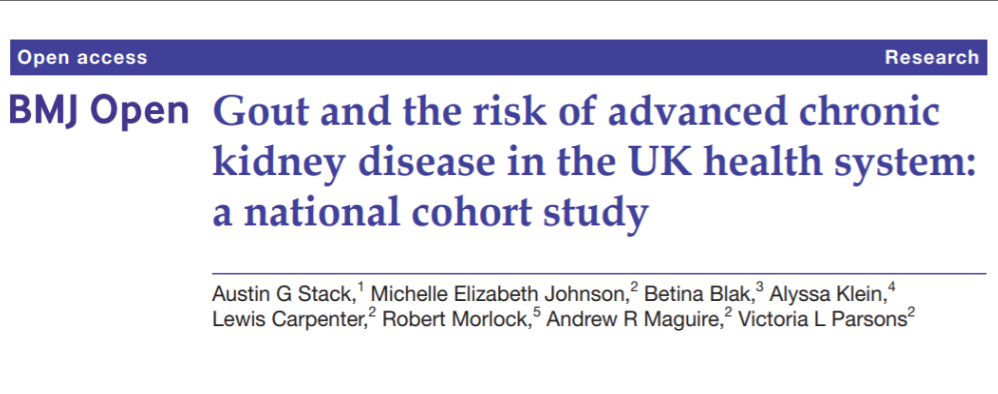Authors: Stack, Austin Johnson, Michelle Blak, Betina Klein, Alyssa Carpenter, Lewis Morlock, Robert Maguire, Andrew Parsons, Victoria.
Abstract
OBJECTIVE: Evaluate association of gout with progression to advanced CKD in a national study.
METHODS: Retrospective matched cohort study of 68,897 adults with gout and 554,964 without gout from the UK Clinical Practice Research Datalink. Multivariable Cox regression compared hazard ratios (HRs) of advanced CKD in gout patients versus patients without gout, adjusting for demographic, clinical, and socioeconomic factors, adjusted Charlson comorbidity score, and medication use. Sensitivity analyses included propensity-score matched comparisons and analysis restricted to patients with incident gout. RESULTS: Incidence of advanced CKD was higher for patients with gout (8.54 per 1000 patient-years; 95% confidence interval [CI], 8.26-8.83) versus without gout (4.08; 95% CI, 4.00-4.16). In unadjusted analysis, gout was associated with higher risk of advanced CKD progression (HR, 2.00; 95% CI, 1.92-2.07). After adjustments, gout remained associated with a higher risk of advanced CKD (HR, 1.29; 95% CI, 1.23-1.35). Association was strongest for outcome of end-stage kidney disease (HR, 2.13; 95% CI, 1.73-2.61) but was also present for eGFR <10 ml/min/1.73m² (HR, 1.45, 95% CI, 1.30-1.61), and doubling of serum creatinine (HR, 1.13, 95% CI, 1.08- 1.19), but not death associated with CKD (HR, 1.14, 95% CI, 0.99-1.31). Association of gout with advanced CKD was replicated in propensity-score matched analysis (HR, 1.23, 95% CI, 1.17-1.29), and in analysis limited only to incident gout patients (HR, 1.28, 95% CI, 1.22-1.35).
CONCLUSIONS: Gout is associated with elevated risk of progression to advanced CKD. Future studies should investigate whether gout control is protective and reduces future CKD risk
Stack AG, Johnson ME, Blak B, et al. Gout and the risk of advanced chronic kidney disease in the UK health system: a national cohort study. BMJ Open. 2019;9(8):e031550. Published 2019 Aug 28. doi:10.1136/bmjopen-2019-031550
